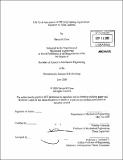Life cycle assessment of off-grid lighting applications : kerosene vs. solar lanterns
Author(s)
Dave, Shreya H
DownloadFull printable version (6.747Mb)
Other Contributors
Massachusetts Institute of Technology. Dept. of Mechanical Engineering.
Advisor
Timothy Gutowski.
Terms of use
Metadata
Show full item recordAbstract
Access to electricity in developing countries is minimal and if available, often unreliable. As a result, fuel-based kerosene lighting is the most common solution to lighting necessities. However, kerosene combustion affects indoor air quality and relies on a non-renewable fossil fuel subject to price volatility. Thus, solar lanterns are being introduced to developing markets, but incur their own energy and emissions intensity from more complex manufacturing processes and requirements. Life cycle assessments examine the energy required and the emissions released over the entire existence of a product or process to allow for quantitative comparison among technology options. The results from a "cradle-to-user" life cycle assessment of the lighting options are displayed in Figure 1 below ... The values reported do not clearly indicate that it is a sustainable decision to transition to solar-based lighting from the conventional use of kerosene combustion. However, understanding the data presents further opportunities for reducing the impact of lighting. The economic payback time of a solar lantern, the distribution emissions in location and time, and the challenges of implementation on a large scale are among these critical review considerations.
Description
Thesis (S.B.)--Massachusetts Institute of Technology, Dept. of Mechanical Engineering, 2008. Cataloged from PDF version of thesis. Includes bibliographical references (p. 37-38).
Date issued
2008Department
Massachusetts Institute of Technology. Department of Mechanical EngineeringPublisher
Massachusetts Institute of Technology
Keywords
Mechanical Engineering.